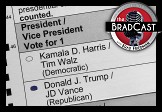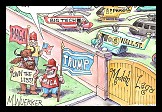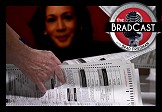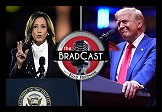Guest blogged from D.C. by Margie Burns
Beneficiary of yet another political outing, the Washington Post ran an article on Thursday June 21, 2007, titled “Political Hiring in Justice Division Probed,” strongly alleging further personnel atrocities committed in the DOJ by former Civil Rights Division administrator Bradley Schlozman.
Not to throw the baby out with the bathwater --- this is not a defense of Schlozman --- but regrettably all the allegations were made by unnamed sources. So who are the unnamed administration sources, and why are they engaging in this maneuver?
Here, along the lines of the "numbers" speech by Erin Brockovich as played by Julia Roberts, is the rundown:
Number of grafs, total, in the two-page article: 29. Number of named sources: 2. (See below.) Number of items attributed to unnamed sources: at least 17. Number of unnamed sources, total: uncertain, but ranging from at least 6 to perhaps at most 16.
0
Graf 2: “ . . . according to four lawyers who said they heard the account from Dugan.”
Graf 3: “In another politically tinged conversation recounted by former colleagues, . . .”
Graf 4: “That account was challenged by six officials in the division who said in interviews that they either overheard him . . .”
Graf 14: “Appellate lawyers said that before Schlozman arrived, the small staff enjoyed a collegial work environment . . .”
Graf 15: “ . . . according to five lawyers who spoke on the condition of anonymity because – like most of those interviewed for this article – they still work at the department.” “ . . . whether career lawyers handling politically sensitive cases were ‘on our team,’ the lawyers said.”
Graf 16: “Schlozman raised the question of partisan politics bluntly in the fall of 2004, they said . . .”
Graf 17: “ . . . according to colleagues who said they heard Flynn describe the exchange.” “ . . . and started looking for another job, the lawyers said.”
Let’s see: 4 "lawyers" plus 6 "officials" plus 5 "lawyers" --- for a change --- equals 15 lawyers or officials so far, operating on the admittedly hypothetical assumption that these are all separate individuals. So either we have a virtual horde of admin officials all leaking the same narratives at the same time, to the WashPost, or the paper has cited the same sources over and over, in slightly different-sized clumps each time regarding different occasions, deliberately to create an impression of more sources than there actually were.
Then we get:
Graf 18: “ . . . according to the lawyers and one of the supervisors . . .”
i.e., the same 5 lawyers last named, or unnamed, plus a supervisor, hypothetically upping the total of official sources in the DOJ to 16. Sweet sixteen.
Graf 21: “ . . . she was given only deportation cases, as were some of her colleagues, several lawyers said.” “According to sources in the office, . . .”
At this stage in the narrative, the attributions get somewhat more elastic:
Graf 22: “According to sources familiar with both women’s accounts, . . .”
Graf 23: “Friends said she confided that she did not want to give up her Justice job . . .”
Graf 24: “ . . . sources said . . .” “ . . . colleagues said . . .”
Friends, sources, colleagues, Lend me your ears! I come not to bury Schlozman, but to ---
Graf 26: “ . . . said one lawyer in the section . . .”
Do your own hand count by all means, but I make it 17 attributions to unnamed sources, most of them identified as within the Justice department, or at least implied to be in Justice, in 29 paragraphs.
I love newspapers, and I am wholly committed to a free press – which is where I come in, as a journalist – although not I alone, and that’s not the only place where I come in. But the stuff going on in this article, once you look at it closely, would be frowned upon in the Waukesha weekly, much less a paper the heft of the Washington Post.
This is still the WashPost still piling on, still trying to show that it has what it takes to “bring down” an administration.
How can you tell? – easy: If you can’t follow the numbers – and I defy any reader, however informed, to do that – then follow the dates. Here’s how the article begins:
Good first graf. This is a juicy story up to a point --- but only up to a point, since the events narrated 1) happened in 2005, and 2) are mainly corrected by now – but we don’t find out about that until paragraph 27 of a 29-graf article. The lead paragraphs do not mention that by now all three women are returning to the division, information not vouchsafed the reader until deep, deep down on the inside page:
Stevens, who hired a lawyer and filed an Equal Employment Opportunity complaint after the transfer, reached a confidential settlement with the department after Schlozman left the division and returned to her old job in the fall of 2006. Justice officials agreed that Calderon and Kwong should return as well.
So however belatedly, some justice was retrieved and some redress accomplished – without the help of the watchdog press, which did not run these articles back in 2005 – February, March, June, November and December 2005, according to the unnamed sources – when the events were taking place meaning the three women probably could have used the help. Where was the WashPost then?
Easy answer: back then, the WashPost cast a collective terrified eye on Bush’s at-the-time-higher standing in the opinion polls, and did not progress much beyond that. The exceptions – wonderful reporters who genuinely pursue, and try to convey, the facts – are typically sent to the world’s most dangerous places; Kevin Sullivan, Mary Jordan, Craig Whitlock. This is a regular practice of the Post first pointed out to me years ago, sort of a David and Uriah action without the love interest.
For that matter, where was the reporting in fall of 2006, when we had an election approaching and the public might have benefited from knowing about these shenanigans? Well, if I'm going to ask and answer my own question . . .
And why did the WashPost, not having weighed in either when the events occurred or when the women were vindicated, weigh in last Thursday, June 21, 2007?
Easy answer: because that day had two congressional hearings pertaining to the DOJ, thus maximum impact for another piling-on article (from the newspaper that raised practically no outcry about the 'countdown' leading to the Iraq war in 2003 or the ‘torture memos’ of 2002 or the surveillance plans of 2001, etc.). Indeed, senators referred to this particular Post article in the Senate Judiciary Committee hearing on Thursday. The story was timed unsubtly to toss a ball to senators who would be unaware of the behind-the-scenes jostling at the Post – explains why the Post couldn’t wait around for sources willing to speak on the record.
Oh, and also: Bush’s standing in the opinion polls is now way WAY down. Now that hundreds of thousands of helpless Iraqis have died, and almost 4,000 US soldiers, and the US economy is largely a front economy, and our "peace benefit" safely swept off the table in a harpies' banquet --- NOW the WashPost is doing a scant fraction of the reporting it could have done in 2001, on the Bush-Cheney strategy of politicizing every government agency at every level.
Then there’s that little matter of the only two sources of juicy comments directly identified by name, but both quoted secondhand rather than first --- a lawyer named Conor Dugan and a section chief named Diana Flynn:
Conor, acushla, didn’t anyone ever warn you not to confide in co-workers over a beer, even if it is Guinness, and even at the venue of one of those button-down bars named Hanrahan’s? Remember Dave Barry’s observation that those faux watering holes get named after a fictional Irish innkeeper because the actual backing, “Six Proctologists in search of a Tax Shelter,” wouldn’t sound so good?
Ditto for Diana Flynn, also named directly but quoted secondhand:
. . . That spring, Schlozman told a resistant Flynn to transfer Stevens to the disability rights section. According to sources in the office, Schlozman instructed Flynn to tell Stevens that the transfer was related to performance and was her idea.
In June [2005], Flynn told Stevens, who was then several months pregnant, that she had to leave. According to sources familiar with both women’s accounts, Flynn alerted Stevens that “the front office didn’t want the transfer attributed to them” but that it was not Flynn’s idea.
This one sounds more like telephone conversations and the women’s restroom than Hanrahan’s.
“Flynn declined to comment for this article.” Now that the dust has lifted, and men saw what had occurred, Flynn is a-hugging third or rather is safely still Appellate Section Chief in the Civil Rights Division of the DOJ.
Likewise, for reasons that can only be surmised, “Dugan declined to comment.” Judging from some of his reviews of Catholic reading, including a highly favorable review of one of Bill Buckley’s religious books, and from his Friendster web page, Conor B. Dugan is a devout Catholic who practices law in the DC metro area but is no longer with the DOJ. He seems to have been involved in several cases alleging religious discrimination in which DOJ lawyers joined as amici.
So who exactly hung Diana Flynn and Conor Dugan out to dry, and why? The lawyers currently serving under Diana K. Flynn as section chief are Dennis J. Dimsey, Gregory B. Friel, Mark L. Gross and Jessica D. Silver.
And exactly what were the mechanics of this little press op? – Did a number (6 to 16) of DOJ lawyers and other officials spontaneously get together and determine to feed Dugan and Flynn to the WashPost? Did some higher authority give them a go-ahead? Obviously the unnamed sources still in the dept felt permitted to talk, talking rather freely, it seems, except for that little detail of their own names. Why? Who gave them permission? Is someone in the DOJ giving the Post friendly strokes? Or is the ur-source, the source behind the sources, the great silent authorizer, even in the DOJ? And what's with the essential blandness, once you look at it, of imparting a tidbit that's two years old --- another number --- as though it were news, and an office injustice after it has already been largely fixed? What could even conceivably be the point, beyond 1) giving the reporter a 'stroke,' as they call it in the monkey world, or 2) further damaging the DOJ? It doesn't even seem to be very retributive; Flynn is still safely in the division, and Dugan is safely out.
Compared to that earlier gaffe when the WashPost ran full-tilt with the falsehood that DOJ officials had ranked US Attorney Patrick J. Fitzgerald as ‘middling’ or whatever, debunked on bradblog, this is higher-caliber stuff. That is, the Post is getting a higher caliber of plants from unnamed officials, and evidently from more officials at that, though the exact number remains unspecified. The possible maximum of 16 sounds a bit high; if there are really 16 full-time DOJ officials pushing a story like this, then the admin has a full-fledged mutiny on its hands --- and THAT is the real story, not the two-years-old unkindness now partly resolved.
What is grating, aside from immediate issues, is that the basic story here purported to be partly about a Department of Justice, in our country, discriminating against women in minority groups. Every agency in the Bush administration tends to do this to some extent: OF COURSE these guys tilt toward the white, the male, the moneyed and powerful. This inevitability could have been reported amply by the Post back during the 2000 election. Instead, it opted to foreground the selective importance of a limited few women and minority insiders within the Bush chosen circle – Condoleezza Rice, Karen Hughes, Alberto Gonzales --- preserving the veneer of a paper-thin 'diversity' for Team Bush while quietly angling toward that half-billion-dollar payoff of 'education reforms' that benefit PostCo subsidiary Kaplan.
For now, once again, it looks as though the deeper story – more administration items planted on reporters as willing tools – was scanted. Wonder why the newspaper always leaves that part out. The more an administration gets privileged to use a major newspaper – or any news organization – as its own personal window box, for planting at will, the less credible a blanket confidentiality principle for journalists becomes, and the weaker the protection offered by the First Amendment. But some reporters eagerly cultivate being planted upon. And the reporters who eschew these items don’t put the articles into print in the first place. So either way, the public seldom learns about the behind-the-scenes maneuvering.


 How (and Why!) to 'Extend an Olive Branch' to MAGA Family Members Over the Holidays: 'BradCast' 11/21/24
How (and Why!) to 'Extend an Olive Branch' to MAGA Family Members Over the Holidays: 'BradCast' 11/21/24 'Green News Report' 11/21/24
'Green News Report' 11/21/24
 Former Federal Prosecutor: Trump Must Be Sentenced in NY Before Taking Office Again: 'BradCast' 11/20/24
Former Federal Prosecutor: Trump Must Be Sentenced in NY Before Taking Office Again: 'BradCast' 11/20/24 'Bullet Ballot' Claims, Other Arguments for Hand-Counting 2024 Battleground Votes: 'BradCast' 11/19/24
'Bullet Ballot' Claims, Other Arguments for Hand-Counting 2024 Battleground Votes: 'BradCast' 11/19/24 'Green News Report' 11/19/24
'Green News Report' 11/19/24 Trump Already Violating Law (He Signed!) During Transition: 'BradCast' 11/18/24
Trump Already Violating Law (He Signed!) During Transition: 'BradCast' 11/18/24 Sunday 'Into the Gaetz of Hell' Toons
Sunday 'Into the Gaetz of Hell' Toons Computer Security Experts Ask Harris to Seek Hand-Counts Due to Voting System Breaches: 'BradCast' 11/14/24
Computer Security Experts Ask Harris to Seek Hand-Counts Due to Voting System Breaches: 'BradCast' 11/14/24  'Green News Report' 11/14/24
'Green News Report' 11/14/24 Trump Criminal Cases Fade After Election as GOP 'Does Not Believe in Rule of Law': 'BradCast' 11/13/24
Trump Criminal Cases Fade After Election as GOP 'Does Not Believe in Rule of Law': 'BradCast' 11/13/24 Climate Advocates Brace for Fight With Trump 2.0: 'BradCast' 11/12/24
Climate Advocates Brace for Fight With Trump 2.0: 'BradCast' 11/12/24 'Green News Report' 11/12/24
'Green News Report' 11/12/24 Let It All Out: 'BradCast' 11/11/24
Let It All Out: 'BradCast' 11/11/24 Sunday 'Like it or Not' Toons
Sunday 'Like it or Not' Toons Not All Bad: Abortion Rights Won Big (Almost) Everywhere: 'BradCast' 11/7/24
Not All Bad: Abortion Rights Won Big (Almost) Everywhere: 'BradCast' 11/7/24 'Green News Report' 11/7/24
'Green News Report' 11/7/24 U.S. CHOOSES CONVICTED CRIMINAL, ADJUDICATED RAPIST: 'BradCast' 11/6/24
U.S. CHOOSES CONVICTED CRIMINAL, ADJUDICATED RAPIST: 'BradCast' 11/6/24 ELECTION DAY 2024: Tea Leaves, Probs for Voters, What's Next: 'BradCast' 11/5/24
ELECTION DAY 2024: Tea Leaves, Probs for Voters, What's Next: 'BradCast' 11/5/24 'Closing Arguments' for Undecideds, Third-Party Voters: 'BradCast' 11/4/24
'Closing Arguments' for Undecideds, Third-Party Voters: 'BradCast' 11/4/24 The GOP 'Voter Fraud' Before the Storm: 'BradCast' 10/31/24
The GOP 'Voter Fraud' Before the Storm: 'BradCast' 10/31/24 'Closing Arguments'with Digby and Driftglass: 'BradCast' 10/30/24
'Closing Arguments'with Digby and Driftglass: 'BradCast' 10/30/24 Trump Promises to be a Lawless, Authoritarian President. Believe Him: 'BradCast' 10/29/24
Trump Promises to be a Lawless, Authoritarian President. Believe Him: 'BradCast' 10/29/24 Ballots Burn, Billion-aires 'Obey in Advance', Callers Ring In: 'BradCast' 10/28/24
Ballots Burn, Billion-aires 'Obey in Advance', Callers Ring In: 'BradCast' 10/28/24 Musk's Privatized Internet Satellite System Threatens U.S. National Security
Musk's Privatized Internet Satellite System Threatens U.S. National Security
 VA GOP VOTER REG FRAUDSTER OFF HOOK
VA GOP VOTER REG FRAUDSTER OFF HOOK Criminal GOP Voter Registration Fraud Probe Expanding in VA
Criminal GOP Voter Registration Fraud Probe Expanding in VA DOJ PROBE SOUGHT AFTER VA ARREST
DOJ PROBE SOUGHT AFTER VA ARREST Arrest in VA: GOP Voter Reg Scandal Widens
Arrest in VA: GOP Voter Reg Scandal Widens ALL TOGETHER: ROVE, SPROUL, KOCHS, RNC
ALL TOGETHER: ROVE, SPROUL, KOCHS, RNC LATimes: RNC's 'Fired' Sproul Working for Repubs in 'as Many as 30 States'
LATimes: RNC's 'Fired' Sproul Working for Repubs in 'as Many as 30 States' 'Fired' Sproul Group 'Cloned', Still Working for Republicans in At Least 10 States
'Fired' Sproul Group 'Cloned', Still Working for Republicans in At Least 10 States FINALLY: FOX ON GOP REG FRAUD SCANDAL
FINALLY: FOX ON GOP REG FRAUD SCANDAL COLORADO FOLLOWS FLORIDA WITH GOP CRIMINAL INVESTIGATION
COLORADO FOLLOWS FLORIDA WITH GOP CRIMINAL INVESTIGATION CRIMINAL PROBE LAUNCHED INTO GOP VOTER REGISTRATION FRAUD SCANDAL IN FL
CRIMINAL PROBE LAUNCHED INTO GOP VOTER REGISTRATION FRAUD SCANDAL IN FL Brad Breaks PA Photo ID & GOP Registration Fraud Scandal News on Hartmann TV
Brad Breaks PA Photo ID & GOP Registration Fraud Scandal News on Hartmann TV  CAUGHT ON TAPE: COORDINATED NATIONWIDE GOP VOTER REG SCAM
CAUGHT ON TAPE: COORDINATED NATIONWIDE GOP VOTER REG SCAM CRIMINAL ELECTION FRAUD COMPLAINT FILED AGAINST GOP 'FRAUD' FIRM
CRIMINAL ELECTION FRAUD COMPLAINT FILED AGAINST GOP 'FRAUD' FIRM RICK SCOTT GETS ROLLED IN GOP REGISTRATION FRAUD SCANDAL
RICK SCOTT GETS ROLLED IN GOP REGISTRATION FRAUD SCANDAL VIDEO: Brad Breaks GOP Reg Fraud Scandal on Hartmann TV
VIDEO: Brad Breaks GOP Reg Fraud Scandal on Hartmann TV RNC FIRES NATIONAL VOTER REGISTRATION FIRM FOR FRAUD
RNC FIRES NATIONAL VOTER REGISTRATION FIRM FOR FRAUD EXCLUSIVE: Intvw w/ FL Official Who First Discovered GOP Reg Fraud
EXCLUSIVE: Intvw w/ FL Official Who First Discovered GOP Reg Fraud GOP REGISTRATION FRAUD FOUND IN FL
GOP REGISTRATION FRAUD FOUND IN FL


































